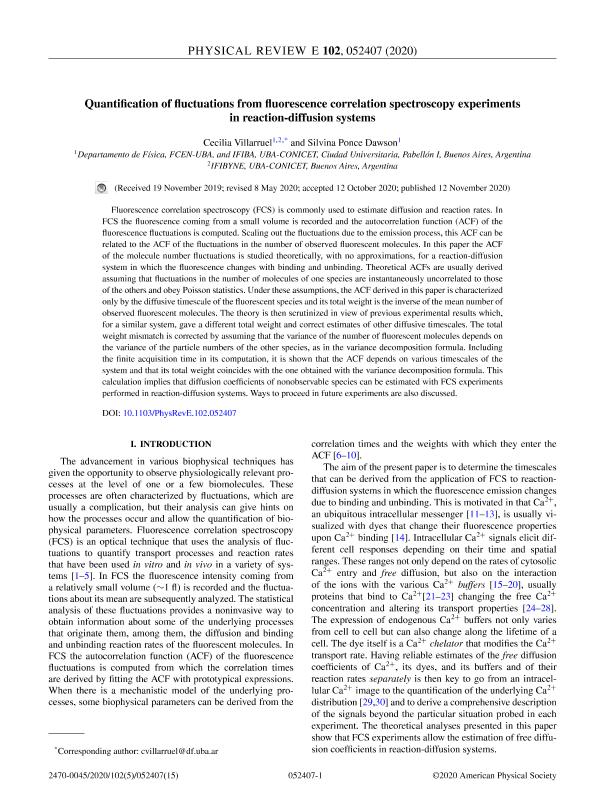Mostrar el registro sencillo del ítem
dc.contributor.author
Villarruel, Cecilia Liliana

dc.contributor.author
Ponce Dawson, Silvina Martha

dc.date.available
2021-11-05T11:51:07Z
dc.date.issued
2020-11
dc.identifier.citation
Villarruel, Cecilia Liliana; Ponce Dawson, Silvina Martha; Quantification of fluctuations from fluorescence correlation spectroscopy experiments in reaction-diffusion systems; American Physical Society; Physical Review E: Covering Statistical, Nonlinear, Biological, and Soft Matter Physics; 102; 5; 11-2020; 5240701-5240715
dc.identifier.issn
1063-651X
dc.identifier.uri
http://hdl.handle.net/11336/146088
dc.description.abstract
Fluorescence correlation spectroscopy (FCS) is commonly used to estimate diffusion and reaction rates. In FCS the fluorescence coming from a small volume is recorded and the autocorrelation function (ACF) of the fluorescence fluctuations is computed. Scaling out the fluctuations due to the emission process, this ACF can be related to the ACF of the fluctuations in the number of observed fluorescent molecules. In this paper the ACF of the molecule number fluctuations is studied theoretically, with no approximations, for a reaction-diffusion system in which the fluorescence changes with binding and unbinding. Theoretical ACFs are usually derived assuming that fluctuations in the number of molecules of one species are instantaneously uncorrelated to those of the others and obey Poisson statistics. Under these assumptions, the ACF derived in this paper is characterized only by the diffusive timescale of the fluorescent species and its total weight is the inverse of the mean number of observed fluorescent molecules. The theory is then scrutinized in view of previous experimental results which, for a similar system, gave a different total weight and correct estimates of other diffusive timescales. The total weight mismatch is corrected by assuming that the variance of the number of fluorescent molecules depends on the variance of the particle numbers of the other species, as in the variance decomposition formula. Including the finite acquisition time in its computation, it is shown that the ACF depends on various timescales of the system and that its total weight coincides with the one obtained with the variance decomposition formula. This calculation implies that diffusion coefficients of nonobservable species can be estimated with FCS experiments performed in reaction-diffusion systems. Ways to proceed in future experiments are also discussed.
dc.format
application/pdf
dc.language.iso
eng
dc.publisher
American Physical Society

dc.rights
info:eu-repo/semantics/openAccess
dc.rights.uri
https://creativecommons.org/licenses/by-nc-sa/2.5/ar/
dc.subject
FLUCTUATIONS
dc.subject
TIMESCALES
dc.subject
FLUORESCENCE
dc.subject
CORRELATION
dc.subject.classification
Otras Ciencias Físicas

dc.subject.classification
Ciencias Físicas

dc.subject.classification
CIENCIAS NATURALES Y EXACTAS

dc.title
Quantification of fluctuations from fluorescence correlation spectroscopy experiments in reaction-diffusion systems
dc.type
info:eu-repo/semantics/article
dc.type
info:ar-repo/semantics/artículo
dc.type
info:eu-repo/semantics/publishedVersion
dc.date.updated
2021-09-07T18:22:05Z
dc.journal.volume
102
dc.journal.number
5
dc.journal.pagination
5240701-5240715
dc.journal.pais
Estados Unidos

dc.journal.ciudad
New York
dc.description.fil
Fil: Villarruel, Cecilia Liliana. Consejo Nacional de Investigaciones Científicas y Técnicas. Oficina de Coordinación Administrativa Ciudad Universitaria. Instituto de Fisiología, Biología Molecular y Neurociencias. Universidad de Buenos Aires. Facultad de Ciencias Exactas y Naturales. Instituto de Fisiología, Biología Molecular y Neurociencias; Argentina. Consejo Nacional de Investigaciones Científicas y Técnicas. Oficina de Coordinación Administrativa Ciudad Universitaria. Instituto de Física de Buenos Aires. Universidad de Buenos Aires. Facultad de Ciencias Exactas y Naturales. Instituto de Física de Buenos Aires; Argentina
dc.description.fil
Fil: Ponce Dawson, Silvina Martha. Consejo Nacional de Investigaciones Científicas y Técnicas. Oficina de Coordinación Administrativa Ciudad Universitaria. Instituto de Fisiología, Biología Molecular y Neurociencias. Universidad de Buenos Aires. Facultad de Ciencias Exactas y Naturales. Instituto de Fisiología, Biología Molecular y Neurociencias; Argentina
dc.journal.title
Physical Review E: Covering Statistical, Nonlinear, Biological, and Soft Matter Physics
dc.relation.alternativeid
info:eu-repo/semantics/altIdentifier/url/https://journals.aps.org/pre/abstract/10.1103/PhysRevE.102.052407
dc.relation.alternativeid
info:eu-repo/semantics/altIdentifier/doi/https://doi.org/10.1103/PhysRevE.102.052407
Archivos asociados
